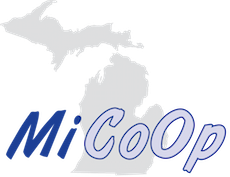 Putting Students at the Center
Putting Students at the Center
The mission of Oxford Community Schools (OCS) is to “provide an education that challenges all students to achieve their maximum potential in academics, arts, and athletics and prepares them to succeed in a global society.” Meeting the academic, social, and emotional needs of every student can be challenging, and Oxford tackles this challenge by viewing its students as individuals. The district looks at all aspects of education, from the programs they provide to the internal systems that exist, and asks “How does this impact student learning?”
OCS has nearly 7,000 students in pre-kindergarten through grade 13. With over 78 square miles in northern Oakland County, it is one of the largest school districts in southeast Michigan. The district is home to five elementary schools, one middle school, one high school, an early learning center, one adjudicated youth facility, one alternative high school, an early college, and a virtual academy. Families can enroll their children as school of choice students through 9th grade and into limited CTE slots in 10th-12th grades.
School leaders have developed an inclusive and shared culture of leadership and inspired a growth mindset in both staff and students. Creating opportunities for all students to succeed has been accomplished by listening and gathering information from staff, students, parents, and community members and constructing shared solutions to their needs. Administrators acquire talent who focus on students and provide the resources they need to learn and grow.
The district continually focuses on improvement. Their Portrait of a Graduate serves as the guiding light when making decisions and has led to many opportunities for individual student growth whether it be through programs or more time with teachers due to streamlined processes and procedures. As a compass, the Portrait fulfills its mission by:
- aligning their strategic plan to it.
- tying the district budget to it (i.e., designating funds to execute it).
- providing professional development to achieve it.
Students are an active participant in their education and refer to the Portrait of a Graduate when talking about their learning journey. A life-size version of the graduate is in buildings, at meetings and events, in print materials, and more to reinforce the commitment by all stakeholders to provide a world-class education for all students.
The Right People
Putting the right people in the right positions is an important goal at Oxford. Many of Oxford’s administrative staff have come to the education field from pathways outside of education. They approach running the district similar to how managers run their companies. Hiring edupreneurs (i.e., entrepreneurs with a knowledge of education) or training staff to think like edupreneurs is a key component to providing the best possible education for their students.
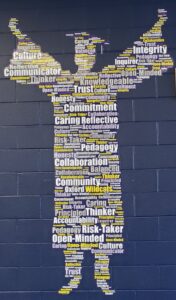 Oxford strives to deliver a high-quality, custom education to all its students. Because people are the deliverers of their service, they look for individuals with high integrity and a passion for helping all kids learn. They seek people who are good listeners, make students feel important and want to engage, are relentless in providing the services kids need, and go above and beyond state requirements to work with students and families.
Oxford strives to deliver a high-quality, custom education to all its students. Because people are the deliverers of their service, they look for individuals with high integrity and a passion for helping all kids learn. They seek people who are good listeners, make students feel important and want to engage, are relentless in providing the services kids need, and go above and beyond state requirements to work with students and families.
Beyond hiring, Oxford’s professional development (PD) has grown over time to mirror their student experience and align with the district’s strategic process and Portrait of a Graduate. From topic interest surveys to teacher-developed and teacher-led PD to choice in learning, teachers throughout the district feel valued and get excited about learning. Instructional coaches assist teachers in their learning, just like a teacher would guide a student. The switch to learner-centered PD has strengthened their commitment to personalizing learning for students.
There is an apparent educational mindset shift in the district. In order to allow teachers and students to learn in a way that is personal to them, professional trust is a must. At Oxford, teachers are given the freedom to meet with colleagues and set curriculum. They are encouraged to work collaboratively to develop new ways for students to have more voice, choice, action, and power in their learning. This trust leads to a comfort level in taking risks. When teachers are comfortable taking risks, they encourage students to also take risks in their learning.
No matter where a staff member is in the organization, they are committed to the Portrait of a Graduate. Whether it’s seeking professional development to improve teaching practices, finding ways to finance new learning opportunities for students, or working to provide students the tools and resources they need, the Oxford Community Schools’ staff keeps students at the core.
Student Focused
In a business model, people buy a quality product or service. Entrepreneurs decide what to offer, how they will offer it, and how many people will buy it based on their research. This is the approach that Oxford Community Schools takes when they focus on providing great programming the students want. When determining the programs to offer, the district studies the market for job demand, reviews articles and reports on up-and-coming careers, looks at Career and Technical Education funding, and seeks input from the students, parents, and local businesses through surveys and focus groups.
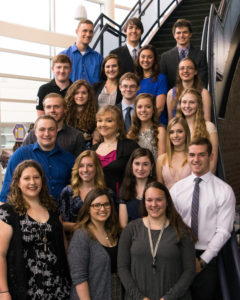
PC: Oxford Community Schools
Through this process, Oxford continues to add programs to meet the needs of a multitude of students in order to provide personalized education. Career learning is embedded at every level beginning with kindergarten. Within the district’s 11 career pathways, students can also choose the format for their learning. While some students choose the traditional brick-and-mortar setting, others prefer an online format or a blending of the two.
Personalizing learning for students is extra work, but staff continue to do it because they like finding what motivates kids and love seeing them get super excited to learn. With guidance, students plan their learning using their Education Development Plans (EDP). These plans align with the Portrait of a Graduate and help them understand why they are in school and begin to imagine themselves as adults.
While families do not directly pay a district for their service in a public school system, they do “pay” by choosing a district. The exceptional programs offered by Oxford have allowed them to increase their School of Choice numbers thus increasing their revenue (Michigan school districts receive funding per pupil). Also, when half of the staff live outside the district but choose to enroll their children in Oxford, they must believe in the personalized quality education offered there.
That personalized quality education encompasses much more than academics. The intentional focus on each student as an individual and their needs is what sets them apart from other districts. After a tragic event in November 2021, Danielle Stublensky, Public Relations Coordinator, shared, “I shudder to think of how much more difficult this road would be had we not already had such practices in place. At Oxford High School, we have 1,800 students in 1,800 different places in their readiness to continue their academics and in their emotional states. It is more important now than ever before that we address and meet the individual needs of our students for their emotional healing and academic journey.”
Leveraging Technology
Oxford leverages technology so staff can spend more of their time with students. One way in which the district manages all its data is with Level Data. Level Data is a company that evaluates a district’s technology needs and then creates a customized solution for the district that takes into account state rules and regulations. Because every district has multiple data systems, Level Data finds solutions where the systems can talk with one another to create efficiencies for the district.
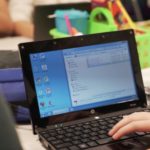
PC: Oxford Community Schools
PowerSchool is one area in which Oxford is taking advantage of these efficiencies. Oxford uses PowerSchool to do more than just manage their student information. PowerSchool tools are used to reduce the number of times the same data must be entered. For example, when an LMS like Moodle, Blackboard, or Google Classroom is used, teachers or IT staff must enter student and parent information even though it already resides in the student information system (SIS). Instead, Oxford has chosen to use the Haiku LMS, a PowerSchool tool that can communicate with Power School’s SIS to populate this data. This LMS is part of PowerSchool’s Unified Classroom, which includes a student information system, assessment, learning, analytics, special education, behavior, and grade book components.
The money saved through the reduction of data entry and login time has allowed the district to reinvest in other areas of the district, those that focus on the student. The district has been able to grow programs and increase professional development and facilities spending from these savings along with donations, matching grants, and additional CTE revenue streams.
Creating Community
The culture at Oxford Community Schools manifests itself in Team O. Important components of the Team O culture are trust, ownership, freedom to learn from mistakes, encouragement, constant communication, and a global mission. It is a family made up of staff, students, families, and the community with all members of Team O striving to exemplify the Portrait of a Graduate.
To build this community, members continually ask one another, “What do you need and how can I/we meet your needs?” This may be done through one-on-one conversations, surveys, or district- or community-wide meetings. The strong professional and personal relationships built through Team O are apparent. Virtual teachers immediately jumped in to help in-building teachers during COVID. Staff work together across buildings and programs for student learning. Team O pulled together to support student emotional and mental health as well as continued learning after a fatal incident.
Oxford Community Schools’ success comes from employing entrepreneurial thinkers who focus on students’ needs, leveraging technology to increase the time spent with students, and creating community. Some of the quality programs offered by Oxford Community Schools to meet student needs through personalized learning are described below.
International Baccalaureate World School
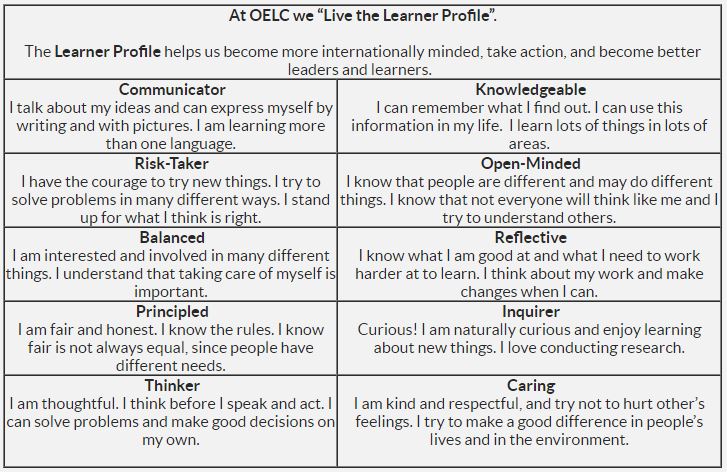
PC: Oxford Community Schools website
Oxford is one of the few PreK-12 International Baccalaureate (IB) World School districts in Michigan. While other districts may have a classroom, grade level, or building IB program, Oxford’s philosophy is “if it’s good for one student, it’s good for all students.” By implementing the program district-wide, all PreK-12th grade students share a common language for learning. The program focuses on the whole child with the goal that students will learn for themselves (i.e., learn how to learn). The international focus of the program also ties well with their language instruction which begins in PreK (Spanish/Chinese).
The IB program uses a different thought process for learning which is ‘learn, reflect, learn.’ While Oxford uses its own curriculum/content, it designs it with the IB inquiry and backward design structure. As students learn, they demonstrate their knowledge of the curriculum through action and are allowed to make mistakes as that is where we do some of our best learning. Oxford is moving toward district-wide competency-based education and demonstrating learning also aligns with that model. Learning within all areas of Oxford’s traditional system is being influenced and changed by IB.
The IB learner profile begins in preschool and continues with them through all their years at Oxford. The outcome of the IB program is that students become more internationally minded, take action, and become better leaders and learners. At the elementary schools, fifth-grade students take action through a three-month, collaborative research project (Exhibition), and middle school students take action through a personal project. While every student pre-K through 10th grade is an IB student, they can choose to continue the IB program in 11th and 12th grade through the Diploma Programme (see High School section).
Students and staff in every building are supported by an IB Coordinator. This position plans and oversees the program from teacher training and unit development to student exhibition and evaluation. IB Coordinators work with teachers to design high-quality, rigorous learning experiences that focus on a better and peaceful world. Many IB Coordinators are also curriculum coaches in the district.
Focusing on Student Learning Starts Early
The IB framework is part of the culture in every elementary school building. Through the six themes (trust, integrity, commitment, collaboration, honesty, accountability), students learn how to learn and how to do life at every stage of their growth. They gain skills to deal with inevitable change, model their learning, and are able to express their growth over time. Passionate learners inquire about topics and students learn how asking questions and taking action will make the world a better place. Teachers develop curriculum relevant to their students’ lives and build intentional connections with students and families.
In Rachel Hart’s 4th-grade classroom at Oxford Elementary School, students engage with the six IB themes on a personal level. While discussing books in a writers’ workshop lesson, students apply what the characters are learning to their own lives. Students get comfortable on chairs, buckets, stools, the floor, or a couch to read, write in their notebooks, talk with a partner, or assess their writing. A rubric with a scale of 1, 2, or 3 stars is used to evaluate themselves.
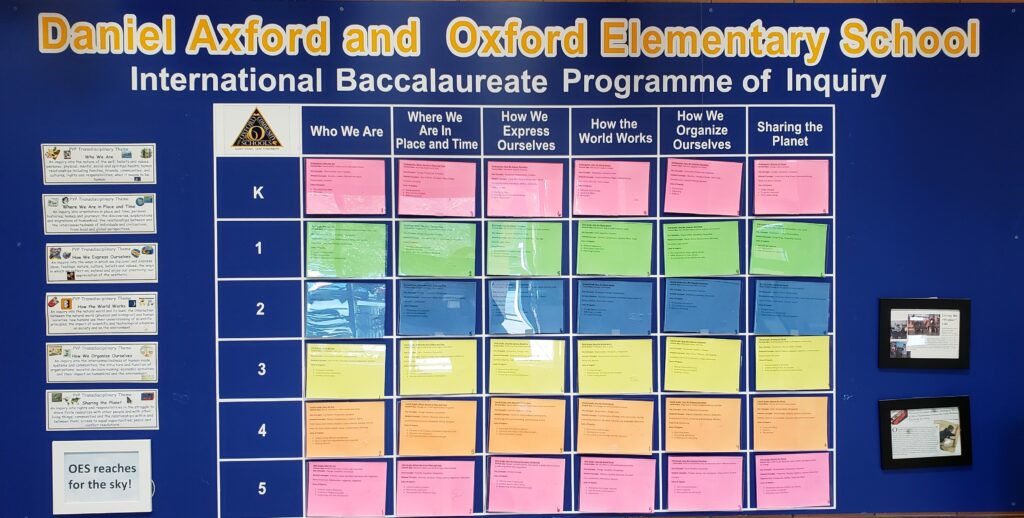
This 3rd-5th grade neighborhood school recently added a STEM (science, technology, engineering, math) room. Green screens, cube, dash the robot, and other tools have been borrowed from the Oakland Intermediate School District’s (ISD) STEM Checkout program which provides equipment to districts to support their K-12 STEM goals. Students and teachers are using the equipment and evaluating future curricula and courses for the room. After school, the room is used for robotics.
Learning at the Middle School
On the east side of town, almost 1,000 Oxford Middle School students take a required Project Lead the Way (PLTW) course. Natalie Daversa, the PLTW teacher who also teaches game design and business/careers classes for Oxford Virtual Academy, has approximately 180 6th-8th grade students each semester. The PLTW pre-engineering sequence includes Design & Modeling (6th grade), Robotics & Automation (7th grade), and Science Technology (8th grade). Once students complete this series they have a basic knowledge of the design process, how technology is used in engineering to solve everyday problems, the mechanics of motion, the conversion of energy, and the use of science and technology to improve communication. Skills learned in PLTW can be taken to the high school to further their engineering knowledge.
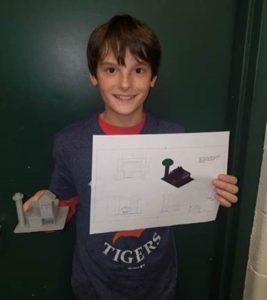
PC: Oxford Community Schools
One lesson in the Design & Modeling course requires students to create a house in Inventor software. After designing their homes, students rotate from computer to computer as a gallery-type walk. Voting on the best-designed house is done through Google Forms with the winner’s design 3D printed. In another project, students are asked to envision and design ‘Oxford Schools’ in 3D block letters similar to the “Hollywood” sign in California. Ms. Daversa also collaborates with middle school teachers to integrate other subjects into the PLTW courses.
About fifty percent of the 8th-grade class goes into high school already completing Algebra and/or Geometry. Students who may struggle in math can enroll in Taylor LaMagna’s Math Lab elective course. In this class, she works with students who are at different places in the curriculum. As an 8th grade Math, Algebra, and Geometry teacher, she is able to personalize learning so each student can move along the math curriculum at their own pace and be ready for high school.
Teachers at the middle school have the opportunity to co-teach. Daily grade-level common planning time and weekly professional development contribute to this model’s success. Andrew McDonald and Jennifer Croteau, sixth-grade science teachers, co-teach 64 students. They use the library to gather their students for unit/lesson introductions and wrap-ups as well as gallery walks, while the hands-on science experiments are completed in their own rooms. The common planning time provides the teachers time to share strategies, keep at the same pace, and support one another. During a lesson, one teacher teaches and the other monitors the room. This co-teaching model also allows students to work on big projects with students from other classes and have a broader group of peers in which to have deeper conversations.
Other options to personalize their learning at the middle school include Spanish, Chinese, online sign language, band, choir, orchestra, and a wide variety of electives from Oxford Virtual Academy (see section below). Students also have access to STEM activities through Oakland ISD’s STEM mobile lab, STEMi.
Personalizing at the High School Level
On the north end of town, Oxford High School delivers a variety of academic studies to prepare students for college and careers. In addition to rigorous core courses, students can enroll in the IB Diploma Programme, Early College, International or Dance Conservatory programs and take AP, dual enrollment, or Career and Technical Education (CTE) courses. Of the 1,800 students enrolled, about 40% take CTE courses and almost 12% are in Early College. Every 9th-grade student enrolls in an online year-long career and college prep soft skills writing class.
Students who choose the International Baccalaureate Diploma Programme (DP) continue their IB curriculum beyond 10th grade. In this program, students become lifelong learners as they learn to be critical and compassionate thinkers. This is done through the DP core and six subject groups. Within the DP core, students reflect on the question “How do we know?”, write a 4,000-word independent essay paper, and complete a creativity, activity, or service project. Each student prepares a portfolio of their work. This two-year, comprehensive curriculum culminates with an IB Diploma which is recognized by colleges and universities around the world.
Students who thrived in the middle school pre-engineering PLTW courses have the option to continue this path in Oxford’s Introduction to Engineering Design PLTW class. Skills are gained in CAD (computer-aided design) and products designed are 3D printed. Students work at their own pace and those who are further advanced help others in the course. Computer Integrated Manufacturing and Principles of Engineering are other PLTW courses students interested in engineering can enroll in. Engineering courses are also offered through Oxford Virtual Academy.
Another engineering option is Oxford’s Career and Technical Education Mechatronics program. Mechatronics combines mechanical engineering, electronics, computer engineering, telecommunications engineering, systems engineering and control engineering. In their first course, Mechatronics I, students learn the design cycle and basic engineering. In Mechatronics II, students spend the first semester building big robots and the second semester studying fluid power, CNC, and welding. In this program, students can dual enroll in a four-credit Lawrence Technological University course and earn College Prep English I credit while taking the course at Oxford. A fourth course students can take in the Mechatronics program is the Senior Capstone Design course. While geared for seniors, advanced juniors may enroll and become independent study mentors during their senior year.
In addition to Mechatronics, the district offers nine other state-approved Career and Technical Education programs. One of these CTE programs is Radio & TV Broadcasting Technology. A professional studio is set up in the school where students learn skills necessary for TV and radio broadcasting. Students gain experience in lighting, directing, graphics, prompter, audio, and on-air talent as they deliver the daily announcements and monthly magazine-style news show, Wildcat Weekend.
Students interested in automobiles can enroll in the Automotive Technician program which is Automobile Service Excellence (ASE) Certified. Starting in 9th grade, students learn theory and can practice in the state-of-the-art facility after passing a safety test to use the equipment. A state certification can be earned after the 3rd year in the program. Students in Automotive IV are provided with real-life, work-based learning experiences in the community. All levels can compete in Skills USA and MITES.
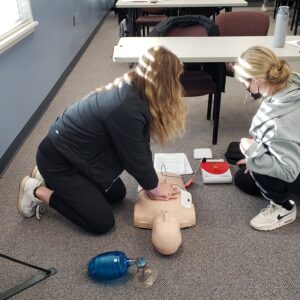 The most recent addition to the CTE Health Science Program is the Emergency Medical Technicians (EMT) course. Students attend a two-hour block class at the Oxford Fire Department where small group hands-on lessons are common. Demonstration of mastery is required and students help each other through unit rubrics. They also visit hospitals, go on ambulance rides, and do other patient care activities for an additional clinical hour. The start of the EMT program, as an extension of the Health Science program, was a combined effort between Oxford High School and the Oxford/Addison Fire Departments to fulfill the need for EMTs in their local community. The success of the program has allowed former graduates to become fully employed at the fire station.
The most recent addition to the CTE Health Science Program is the Emergency Medical Technicians (EMT) course. Students attend a two-hour block class at the Oxford Fire Department where small group hands-on lessons are common. Demonstration of mastery is required and students help each other through unit rubrics. They also visit hospitals, go on ambulance rides, and do other patient care activities for an additional clinical hour. The start of the EMT program, as an extension of the Health Science program, was a combined effort between Oxford High School and the Oxford/Addison Fire Departments to fulfill the need for EMTs in their local community. The success of the program has allowed former graduates to become fully employed at the fire station.
The Oxford International Program (OIP) provides students an opportunity to learn in teams with peers from around the world. Not only do students from OIP’s sister schools in China, Mexico, England, and South Africa come to Oxford to participate, the program is open to any student from around the globe. These students become immersed in American culture and participate in all that Oxford Schools has to offer. Domestic students are also encouraged to study abroad through an exchange program.
Oxford Schools Early College (OSEC) is a five-year option for students who want to earn up to an associate’s degree at no cost while still in high school. College tuition, fees, and textbooks are paid for by the school. OSEC courses may be taken at Oxford High School, Rochester College’s campus, Macomb Community College’s campus, through Oxford Virtual Academy, or a combination of these. Oxford students can earn an Associate of Arts degree from Rochester College or any associate degree from Macomb Community College or Washtenaw Community College. Rochester College also provides scholarships to students to complete their Bachelor’s degree at Rochester if they successfully complete the OSEC program with a B-average.
About 25-30% of OSEC students are completely virtual. Oxford students can actually be virtual students from kindergarten through their 13th year. Full-time OSEC virtual students can use the drop-in lab at Oxford Virtual Academy while Oxford High School students use the drop-in lab in their building. OSEC students have the opportunity to enroll in CTE pathways like marketing, IT, finance, and automotive. Student support and student activities are available to Oxford High School and Oxford Virtual Academy students are also accessible for Oxford Schools Early College students. This includes the National Honor Society and all school sports, clubs, activities, dances, and events.
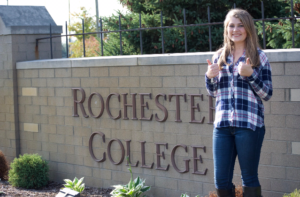
PC: Oxford Community Schools
Flexibility and the freedom to choose their learning path are two main reasons OSEC students enroll in the program. Some even graduate early. Students like that they can work at their own pace while testing the waters of a college-level education. When asked about the support they receive, students mentioned they “interact with the counselor more often because they can stop in the office or schedule appointments whenever they want to.” They also state they are in constant communication with their mentor because they are online.
Every OSEC student completes a senior capstone course during their 5th year. This class revolves around a community service project that they develop and run throughout the year. At the end of the year, there is a gala walk where students share their projects with each other, the school, and the community. One very successful senior project was Oxford Gives Back Spring Cleanup. The OSEC student organized and ran a yard cleanup event for those in need (e.g., the elderly, disabled, etc.). This included getting the word out, signing up yards to be cleaned, registering volunteers (all 800 of them!), and promoting the event. The event provided a great opportunity for the students, the school district, and the community to connect. Another senior organized a car show to raise money for ALS.
Because of the vast number of choices high school students have in their learning, the role of the counselor is extremely important. In their student-centered learning model, every student has an EDP. The counselor assists students in scheduling courses that align with their EDP goals. This makes scheduling courses longer, but the benefits of this process outweigh the costs.
Whether students choose the IB Diploma path, Oxford Schools Early College program, CTE, or Oxford Virtual Academy, they are appreciative of being in charge of their learning. Open-ended projects and discussions, choosing their own project or topic, working at their own pace, and close relationships with teachers are all stated as reasons students are excited about learning at OHS.
Oxford Bridges High School
About 50-60 students in grades 10-12 enroll in Oxford Bridges High School (OBHS), an alternative academic program. To be eligible to enroll in Bridges, students must be behind in credits and are not on track to graduate. Each student receives a personalized, planned program that leads to a diploma. The family/community environment allows students the opportunity to be accepted and supported so they can achieve success in their educational endeavors.
In addition to core teachers who assist students through their individual programs, students have access to an ELL support person. Courses are designed around hands-on curriculum and assessment (i.e., a project-based model). Ninth-grade credit recovery courses in all subjects are available. Students who take virtual courses through Gradpoint or OVA (see below) work in the staffed online learning lab. A shuttle bus runs between the high school and Bridges at the beginning and end of each day so students can participate in elective courses like languages and CTE. Students also have the option to attend O Tech (Oakland Schools Technical Campuses) or receive credit for work-based learning. About 50% of OBHS students plan to enter a trade or business school while 22% and 32% want to attend a four-year or two-year college, respectively.
Oxford Virtual Academy

Oxford Virtual Academy (OVA) opened in 2011 as part of the overall vision to personalize learning for all students in the district. Students can blend their learning by using OVA to create a learning plan that works for them. Over 3,000 students enroll full-time, part-time, or blended every year. Blending learning can include virtual, seated, dual enrollment, college, and partnership courses.
Students are matched with course providers that best meet their individual needs. Because OVA works to personalize education for every one of their students, many homeschool students enroll as well as students whose lives do not fit into a Monday-Friday 8 am-3 pm box. Professional actors for Disney, high achievers, competitive athletes as well as students who want to travel, have severe health conditions, or are in the military (e.g., West Point) attend OVA.
The Academy provides customized rigorous academics directed by the parent and academic expert (mentor) teacher to meet the needs of each student. OVA believes that education is the shared responsibility of students, school, family, and community. They strive to maintain positive relationships with these stakeholders based on trust and the shared belief that the student always comes first.
We’ve come so far from the pencil cup and laptops back in 2011. ~Tracey Hurford, Hybrid Learning Coordinator, said about the lab space.
While most students work in their own spaces (e.g., at home), Oxford Virtual Academy offers two drop-in labs for their students, a K-5 lab and a 6-12 lab. Both labs offer a safe space for learning in a building on the south side of town, not far from the administration building. A math and ELA teacher is always in the lab, and students can schedule an appointment to meet any teacher there. The drop-in labs have a homey feel to them with moveable furniture to accommodate groups as well as individual learning. About 25-30% of fully online students come in when they are struggling, to take exams, or to participate in clubs like Board Game Club or Cricut. A small percentage of students attend the lab every day.
Two K-5 full-time staff (one for grades K-2 and one for grades 3-5) coach parents, assist with interventions and find the “extras” students need. Students in 6th-12th grade have four full-time core teachers and two mentor teachers. The teachers/mentors work 1-2 days in the drop-in lab and 3-4 days from home. Elective teachers connect with students virtually. A K-12 special education teacher is also on staff. In addition to teachers, OVA staff includes a principal, three assistant principals, an instructional coach, four counselors, and a team of student support services employees.
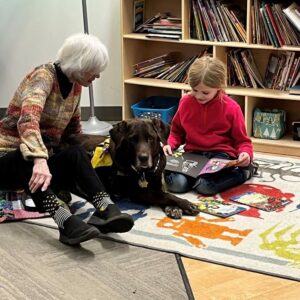
PC: Oxford Virtual Academy Facebook
Helping students succeed is the goal of OVA staff. The K-12 staff meet every week for professional development and to look at data, specifically as it relates to students. OVA teachers use an MTSS that is very data-driven. The intentionality of child study and Tiers 1, 2, and 3 are the same as for in-person students, but interventions are slightly different for the online environment. One tool used to help students stay on track and take ownership of their learning is a learning contract. The support and relationship building students receive are reflected in interviews with high school students. They report that their success comes from “having options to get around brain block with help from teachers and class tips,” “being able to do extra hands-on activities with teachers so they get to know us,” and having the same teacher for multiple grades.
High school students who enroll in OVA share their experience as “better than expected,” “everything you want from an education system,” and “welcomed with open arms.” The ability to approach an assignment in multiple ways and shift assessments to video, Flipgrid, or actually making something (e.g., make a time capsule vs. write about a time capsule) were examples students gave for how OVA personalizes their learning.
Elementary parents are welcome to drop off their children which is uncommon for partnerships with homeschool families. As the Oxford staff builds trust with these families over time, parents are more comfortable congregating in the lounge space or running errands. Unique opportunities for K-5 virtual students include Coding Club, Reading Club, Tech Design, and partnership courses in the community such as photography, karate, and sewing. Leaders in the district encourage Lisa Sullivan, OVA Community Learning Coordinator, to be creative and innovative when finding ways to meet kids’ needs.
Another group that is serviced by OVA is foster youth. Oxford School District has partnered with House of Providence, a home for teen foster youth. Teens who live there take four online core courses with OVA and are supported by the House of Providence staff. Non-core courses like yoga and pottery are also available through Oxford Virtual Academy’s partnerships. As these youth work through their painful pasts and learn to live, OVA is providing an avenue to continue their education without the stress and anxiety that attending “another” school can bring.
Oxford Community Schools has developed a menu of learning options focused on their students. They have hired staff with a passion for meeting every students’ needs and invested in technology that allows more interaction time with students. These components, combined with flexibility and a commitment to their Portrait of a Graduate, provide students with a personalized path for their learning.
Read the Michigan Virtual Learning Research Institute case study on Oxford Community Schools.
Author: Lisa Sitkins, President and CEO, LSS Connections and Consulting LLC, April 2022
